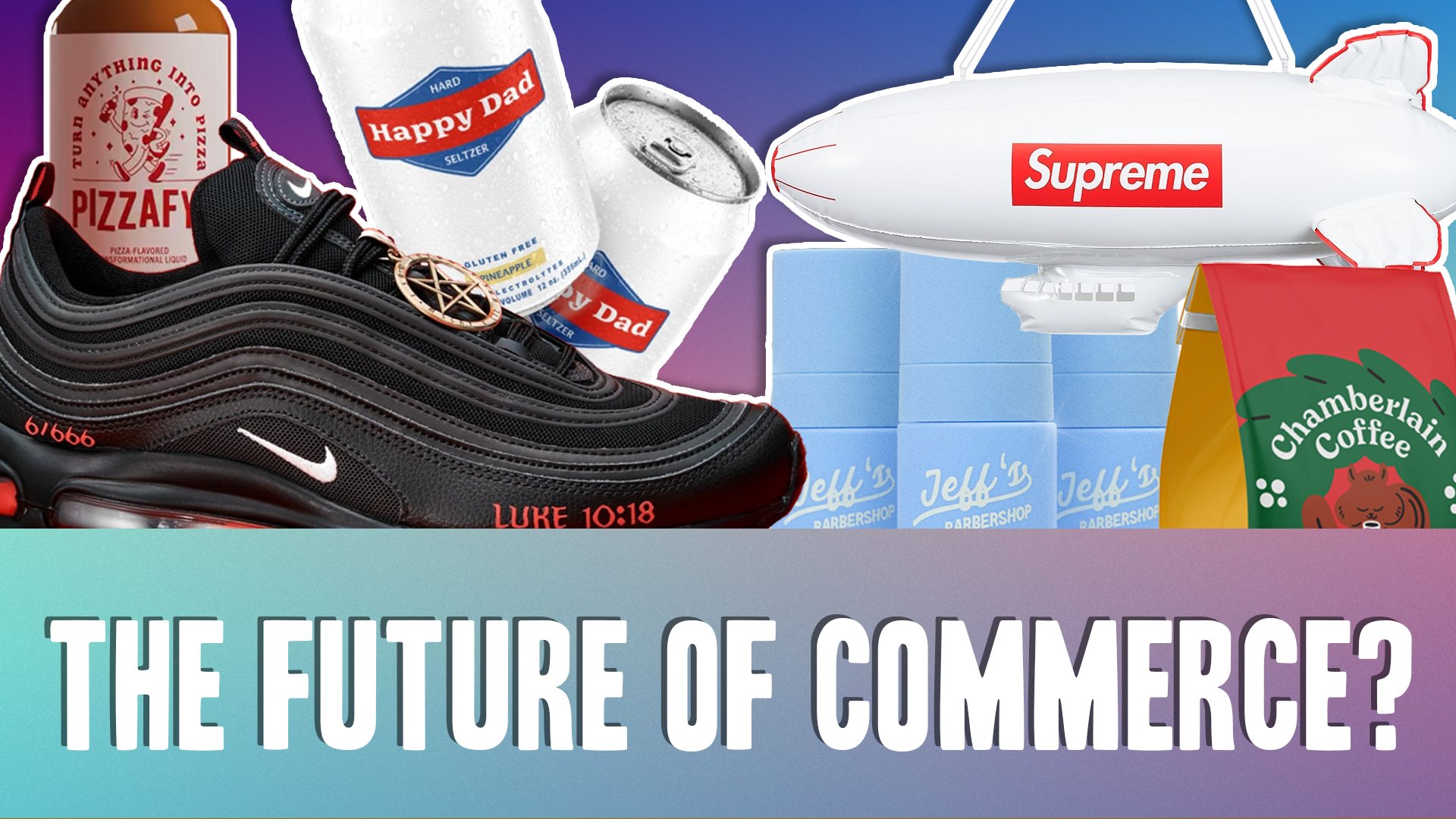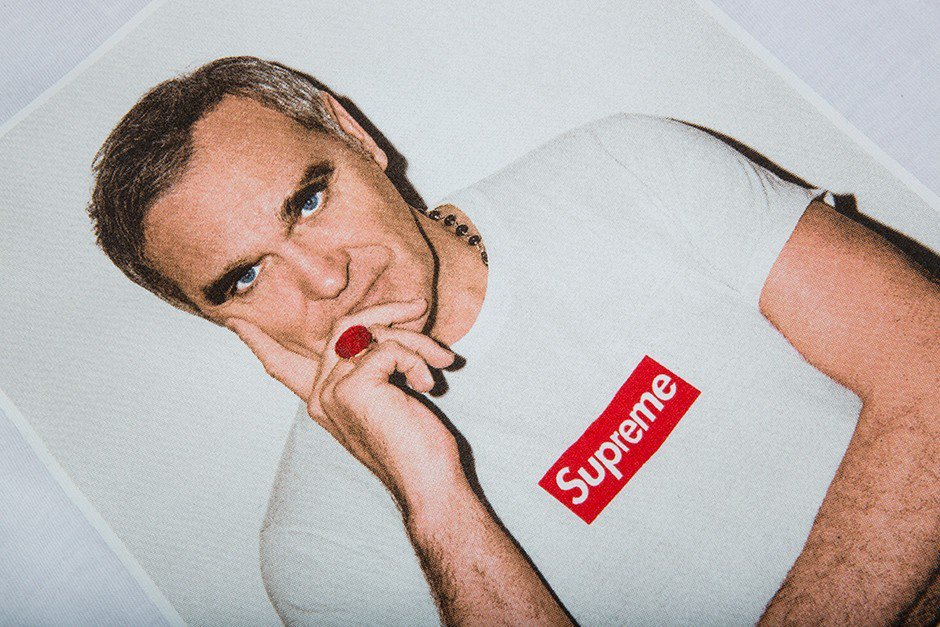Hypebeastery As A Zeitgeist
Photo Illustration by Nathan Graber-Lipperman
The kids who camped outside the Supreme store are now major players in the new economy. On how the drop model revolutionized commerce – and why creators are uniquely positioned to win big.
Essay 3.2 drops on our YouTube channel soon — you can subscribe to get notified as well as read the script below.
On November 11, 2020, MSCHF revealed a new product through their app: A blurred-out image resembling a $20 bill, with a matching asking price to boot.
The art collective hailing from Brooklyn has grabbed countless headlines for their bi-weekly drops since 2019, collaborating with celebrated figures like Lil Nas X and MrBeast while manufacturing a growth engine fueled by hype-based marketing.
But the Blur’s tagline might be the closest thing to a mission statement we’ve seen from MSCHF, selling out of a product that existed solely for – in their words – “the thrill of simply buying.” And yet, even with that seemingly ambiguous messaging, the Blur has featured in videos from creators like David Dobrik and resells for $300 on StockX.
As hypebeast culture seeps into every facet of mainstream commerce, how did we get to this point? And how can creators channel these tactics into a coherent strategy while building out their worlds?
Part I – The Rise of Streetwear
Before we drop a new streetwear-inspired apparel collection or hype up a limited-edition product line, we first need to understand – and pay homage to – where this model of marketing came from.
In tracing the history of contemporary fashion, Tokyo staples such as Hiroshi Fujiwara and Nigo come to mind. But for the purpose of this essay, we’ll start with 1985 New York City designer Daniel “Dapper Dan” Day.
Dan began to style hip hop’s biggest stars out of his boutique in Harlem, outfitting the likes of LL Cool J and the duo Eric B. & Rakim. His flamboyant sense of fashion coupled with his counterfeit use of logos from luxury brands such as Gucci and Louis Vuitton helped him gain notoriety in the city and beyond.
However, when boxer Mike Tyson – wearing a custom piece from Dan himself – got into a brawl outside the store in 1988, the designer reached a new level of fame, drawing headlines from The New York Times. This ultimately led to litigation from the fashion houses and the boutique’s eventual closing, but not before The Times noted the community that Dan’s work had begun to attract, mainly influential artists, performers, and entertainers.
Michael Jordan standing with Mars Blackmon (Photo by Nike)
Around the same time, award-winning director Spike Lee directed and starred in the 1986 film She’s Gotta Have It, where he played a sports fanatic from Brooklyn who loved rocking the latest pair of Air Jordans. The character, Mars Blackmon, was so popular that Lee would reprise the role in Nike commercials alongside Jordan himself, with the ad campaign and Lee’s trademark phrase "It's gotta be da shoes” playing a pivotal role in bringing the sneakers to the mainstream.
As the Chicago Bulls star rose to prominence in the early ‘90s, the Swoosh began to innovate the styles and materials seen on MJ’s feet. By the time the Air Jordan 11 – clad in patent leather and immortalized by Space Jam – debuted in 1996, Nike had mastered the drop model, building anticipation while rolling out different colorways in step with their release calendar.
Between sports, sneakers, and hip hop, this confluence of influences birthed a new form of fashion that kids grew to love. And arguably no brand was more symbolic to what streetwear would become than Supreme.
Part II – From Supreme to StockX
James Jebbia moved to SoHo from England when he was 19, working for a skate shop and a flea market before founding his own place, Union. The latter grew to the point where legendary skateboarder and surfer Shawn Stüssy began to sell his famous clothing line, Stüssy, at Union, and Jebbia eventually transitioned into helping run one of the brand’s stores.
That was, however, until Stüssy retired. So, in 1994, Jebbia pivoted once more and ventured over to Lower Manhattan’s Lafayette Street to open a new skate shop, Supreme. When describing this decision to start over, the entrepreneur told Vogue:
“I always really liked what was coming out of the skate world…it was less commercial—it had more edge and more fuck-you type stuff.”
That authenticity shined through with the space Jebbia created. Between the employees he hired – opinionated cool kids who would “scowl” at the “uncool” – and the neighborhood regulars he welcomed in with open arms, Supreme became less about sales and profits and more a church for his one-of-a-kind community to gather.
From the beginning, Supreme would drop limited amounts of clothing like hoodies and fitted caps, some clad with their now-iconic box logo. Every year, the brand releases two collections, slowly rolling out a few pieces online and in-store from each season’s collection every Thursday. And every Thursday thus becomes an event: nearly all of the products sell out, with eager customers either lined up around the block or sitting in virtual waiting rooms on the website.
Supreme founder James Jebbia, pictured wearing the classic Supreme Box Tee in 2016 (Photo by Business of Fashion)
Now, the success of the drop has always depended on the relationship between a brand’s community and the individual identities of its members. In the case of Supreme, what started as an exclusive clique slowly evolved over the years into a lens in which to celebrate youth culture, as patrons of Jebbia’s store would saunter in blending more traditional skatewear with Jordans, all while blasting their favorite rapper’s latest mixtape.
But something else came along in the back pages of online forums such as NikeTalk: resellers. That authenticity that Jebbia fought so hard for throughout the 90s made Supreme quite sought-after, and eBay was a natural place to auction off rare pieces from the brand’s past for a pretty profit. By the early 2010s, resellers turned to Facebook groups and conventions to avoid eBay fees; then, in 2016, resale platform StockX became a popular destination due to their authentication process and stock market-esque pricing framework.
All of a sudden, there was a defining, algorithm-based rate in valuing the worth of items, a rate that could be referenced in everything from articles to YouTube videos. While word-of-mouth marketing will always reign supreme (pun intended), secondary markets produced a feedback loop that determined what products and brands were worth consuming based on their resale margins over retail prices.
At this point, everyone from the kid in your photography class to marketing executives at Fortune 500s began to realize the importance of building hype around whatever product they were pedaling. And running concurrently with this awakening was the growth of indie sellers opening up online storefronts via e-commerce platforms like Shopify.
Part III – Creators and E-Commerce
In 2006, a couple of snowboarding fans in Ottawa tried to open an online equipment store without much success.
Back then, the barrier to entry for starting a product line was high. Looking at apparel specifically, you either had to partner with big box retailers like Macy’s or Foot Locker; lease your own brick-and-mortar store; sell at events like concerts or conventions; or hack together a website using the tools available.
The slope-loving Canadians opted for the latter. Unsatisfied with their clunky experience in the early aughts, one of them – a programmer named Tobias Lütke – built a streamlined, easy-to-use platform from scratch, and Shopify was born.
In the years since, the global e-commerce market has exploded. In 2014, it was worth around $1.3 trillion; that number leaped up to $4.89 trillion in 2021, nearly a 400% increase just seven years later.
Of course, the growth of companies like Amazon during that time has vastly contributed to the changing landscape. But for small-to-medium-sized businesses focused on building a brand, the appeal of owning a direct line of communication with an audience is often paramount. Which is why Shopify – featuring no-code customization and an app store full of useful integrations – became the industry standard, with over 1.75 million merchants from Gymshark to Kanye West’s Yeezy selling through the platform as of 2022.
With this explosion of decentralized, direct-to-consumer (DTC) brands, the aforementioned barrier began to crack. Continuous innovations throughout the 2010s led to more and more efficient tools, and by the end of the decade, a new slice of entrepreneurs stood to benefit: creators.
As we covered in our story about Dylan Lemay, creators are uniquely accustomed to understanding product-market fit given they engage potential customers in a specific niche at scale. And given how many are approaching their businesses, we’ve reached a point where it goes past throwing together a logo in Paint, slapping it on a t-shirt, and calling it a day.
Jeff Wittek’s line of hair products, currently sold out on his Shopify store (Photo via Jeff’s Barbershop)
One of three million subscribers who tune into Jeff Wittek’s satirical talk show Jeff’s Barbershop? You can style your look just like he does in his videos by buying his original line of hair products. Want to start your morning making coffee just like Emma Chamberlain does in her vlogs? Subscribe through the Chamberlain Coffee website for exclusive perks and free shipping. Plan on hanging out with Airrack when he throws a pizza party to celebrate hitting 10 million subscribers? Purchase his Pizzafy sauce in the meantime and turn everything you eat into America’s favorite food.
While many of these small media businesses don’t have the accumulated wealth of traditional retailers or the backing of institutional investors, they could now list products online at significantly lower costs – sometimes without holding any inventory. When you can design, sell, and fulfill orders on-demand with platforms like Printful – which seamlessly integrates into e-commerce sites built on Shopify and its contemporaries, including Fourthwall and Squarespace – the only real limit becomes an investment in time and creative energy.
Nevertheless, those last two factors aren’t something to disregard outright. Given the proliferation of new brands, it naturally becomes more difficult to stand out, especially given the frenetic pace at which the zeitgeist moves nowadays.
So as creators, when putting our carefully cultivated brand on the line as we dive headfirst into a new venture, what can we learn from the evolution of streetwear – and pair with the powerful e-commerce tools at our disposal?
Part IV – Products As Experiences
In 1999, author Naomi Klein wrote her manifesto on global capitalism, No Logo, arguing that marketing had replaced manufacturing as the most vital cog in a company’s well-oiled machine.
Two decades later, her words ring truer than ever. Thing is, you don’t have to be a creator with millions of followers to launch a product; as Klein noted, manufacturing is now the easy part. The beauty of the creator economy is that you can have only 1,000 followers and still work with companies like Pietra for all of your sourcing and fulfillment needs, using the same suppliers as Adidas and Urban Outfitters.
It’s the marketing layer on top that establishes the types of blue chip brands Wittek, Chamberlain, and Airrack are shooting for. And as we’ve talked about throughout this essay, there’s two key components to consider here: hype and distribution.
First, when channeling excitement around our drops, remember that we can’t survive off of hype alone. To keep people interested long-term, there has to be a meaningful culture or message behind them; on top of that, we do need to deliver a product to a level of quality determined by the community. Yes, the MSCHF Blur has been given value by the algorithmic overlords of StockX, yet the original item wouldn’t have sold out without the original fanbase and their love for the art collective’s nihilistic commentary on capitalism in the age of the Internet (genius irony in of itself).
Similarly, even as Supreme has become a target for streetwear purists who argue that the company is an example of resellers holding outsized influence, it’s important to remember its origins as a haven for outsiders. Kim Jones, Louis Vuitton’s menswear designer, told Vogue about many of the fascinating individuals she observed still rocking with the brand to this day:
“When you see the lines for Supreme in New York or London…you see so many different types of people, and they are people you can relate to—they understand high-low, they’re smart, they’re intelligent, and they’re humorous.”
Second, we need to approach distribution as more than just which way we decide to neatly package our parcels. Given the vast competition, attention is fleeting nowadays. Therefore, if we want our drops to be successful, we need to turn them into a shared experience. When speaking about this newfound dynamic of modern marketing, Julian Darnell, a streetwear retail veteran of labels like Kith and Extra Butter, told Dry Clean Only:
“[The drop cycle] made getting new sneakers (or clothes) an important event rather than just a utilitarian purchase. It made a release a ‘holiday.’ It drove people to seek out their own style, rather than just showing up to a store and buying whatever happened to be available.”
While major players have scrambled to emulate the drop model at large, personally, I believe that creators are best positioned to succeed. The authentic, personable connection we hold with our audience is everything, and release days – when done right – can act as a rallying cry for community members to join their favorite creators on the journey.
The Nelk Boys launch their hard seltzer, Happy Dad, at a partner liquor store (Photo via Happy Dad)
Hate ‘em or love ‘em, the Nelk Boys mastered these two components of hype and distribution as they turned their channel from a prank show to a hub for party content over the course of the last decade. Inspired by Supreme, Nelk drops seasonal collections of their merchandise line, Full Send, through a locked website that goes live only after announcement trailers run at the beginning of their YouTube Premieres. When every frat bro is pulling up to the darty rocking the latest Full Send tank top, fans know they’ll have to follow closely to ensure they don’t miss out on the next release.
Additionally, Nelk employed a similar strategy upon rolling out their new hard seltzer, Happy Dad, even pulling up to liquor stores alongside the crowds of fans who rush to buy the product when it becomes available in their respective states. What’s made Happy Dad stand out is that unlike influencer-led competitors that launched around the same time – such as Travis Scott’s CACTI – Nelk has stood behind Happy Dad at every step of the way, going through rounds of testing the various flavors and even filming the process of building this multi-year project from the ground up (as the ultimate test of product-market fit, their 30-plus-minute documentary has 5.4 million views on their channel).
To conclude, in some respects, when everyone has a streetwear line, nobody has a streetwear line. The counterculture nature in which this movement was born out of was defined by creativity in design, expression through meaning, and scarcity by nature.
Still, a generation of kids has now grown up with a new method of consumption. The modern Salesforce will be closely intertwined with social media, as tools like the drop-centric CRM Laylo lead the charge.
But again, if Klein’s thesis is to be believed, it’s not the software or manufacturers alone that will make or break our businesses. No, the onus will be on us as creators to continuously craft communal experiences worth participating in.
Coverage from Creator Mag.3 continues on! Plus, make sure to catch our video essays by subscribing to our channel.






